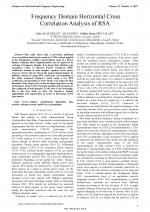| 2/2022 - 1 | View TOC | « Previous Article | Next Article » |
Frequency Domain Horizontal Cross Correlation Analysis of RSAAKALP KUZU, E. |
| Extra paper information in |
| Click to see author's profile in |
| Download PDF |
Author keywords
ciphers, classification algorithms, data security, leakage currents, public key cryptography
References keywords
analysis(17), power(14), correlation(12), attack(11), systems(10), embedded(9), attacks(9), hardware(8), cryptographic(8), information(6)
Blue keywords are present in both the references section and the paper title.
About this article
Date of Publication: 2022-05-31
Volume 22, Issue 2, Year 2022, On page(s): 3 - 10
ISSN: 1582-7445, e-ISSN: 1844-7600
Digital Object Identifier: 10.4316/AECE.2022.02001
Web of Science Accession Number: 000810486800001
SCOPUS ID: 85131767163
Abstract
This study shows that a previously published cross correlation based power analysis (CCPA) attack applied to the Montgomery Ladder exponentiation steps of a Rivest Shamir Adleman (RSA) implementation can be improved by working in frequency domain. It is shown that utilizing cross correlation values of discrete Fourier transform (DFT) coefficients instead of time samples, requires lesser power traces to retrieve the key bits of the target implementation. In addition, instead of using DFT coefficients corresponding to the whole measured frequency band, using a few DFT coefficients corresponding to lower bands, even under the first harmonic of the target clock is also an improving factor on the performance of the CCPA. Practical and theoretical results are also compared to both domains. To the best of our knowledge, this is the first study to show the frequency domain applicability and superiorities in terms of horizontal CCPA type attacks. |
| References | | | Cited By |
Web of Science® Times Cited: 1 [View]
View record in Web of Science® [View]
View Related Records® [View]
Updated today
SCOPUS® Times Cited: 1
View record in SCOPUS® [Free preview]
View citations in SCOPUS® [Free preview]
[1] Trace Alignment Preprocessing in Side-Channel Analysis Using the Adaptive Filter, Gu, Shuyi, Luo, Zhenghua, Chu, Yingjun, Xu, Yanghui, Jiang, Ying, Guo, Junxiong, IEEE Transactions on Information Forensics and Security, ISSN 1556-6013, Issue , 2023.
Digital Object Identifier: 10.1109/TIFS.2023.3310350 [CrossRef]
Disclaimer: All information displayed above was retrieved by using remote connections to respective databases. For the best user experience, we update all data by using background processes, and use caches in order to reduce the load on the servers we retrieve the information from. As we have no control on the availability of the database servers and sometimes the Internet connectivity may be affected, we do not guarantee the information is correct or complete. For the most accurate data, please always consult the database sites directly. Some external links require authentication or an institutional subscription.
Web of Science® is a registered trademark of Clarivate Analytics, Scopus® is a registered trademark of Elsevier B.V., other product names, company names, brand names, trademarks and logos are the property of their respective owners.
Faculty of Electrical Engineering and Computer Science
Stefan cel Mare University of Suceava, Romania
All rights reserved: Advances in Electrical and Computer Engineering is a registered trademark of the Stefan cel Mare University of Suceava. No part of this publication may be reproduced, stored in a retrieval system, photocopied, recorded or archived, without the written permission from the Editor. When authors submit their papers for publication, they agree that the copyright for their article be transferred to the Faculty of Electrical Engineering and Computer Science, Stefan cel Mare University of Suceava, Romania, if and only if the articles are accepted for publication. The copyright covers the exclusive rights to reproduce and distribute the article, including reprints and translations.
Permission for other use: The copyright owner's consent does not extend to copying for general distribution, for promotion, for creating new works, or for resale. Specific written permission must be obtained from the Editor for such copying. Direct linking to files hosted on this website is strictly prohibited.
Disclaimer: Whilst every effort is made by the publishers and editorial board to see that no inaccurate or misleading data, opinions or statements appear in this journal, they wish to make it clear that all information and opinions formulated in the articles, as well as linguistic accuracy, are the sole responsibility of the author.



